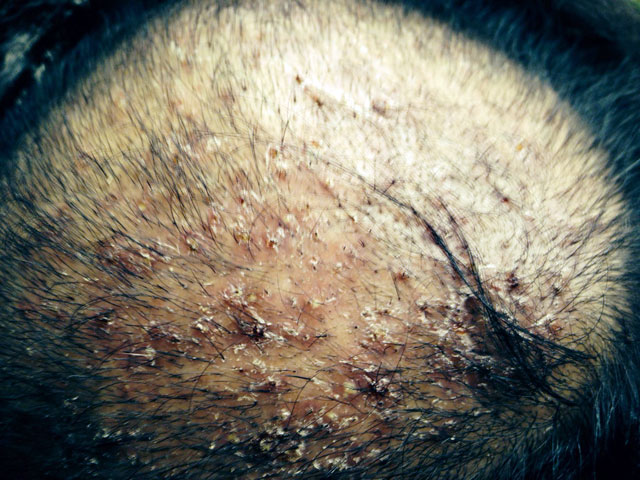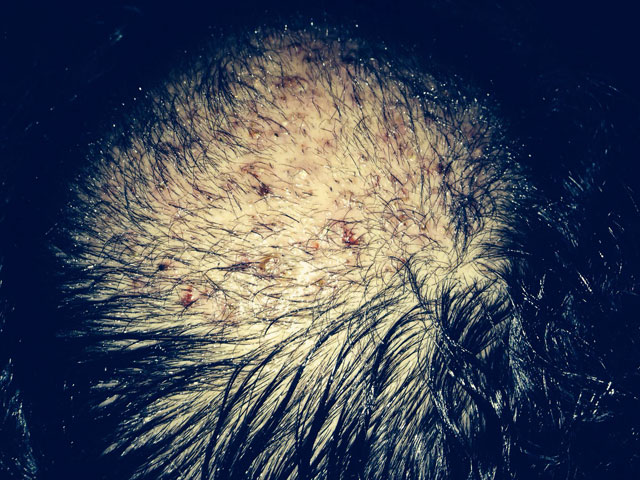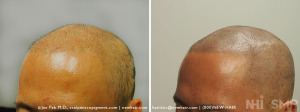This is a young doctor who had a bad hair transplant in his 20’s and since then he has been forced to wear a wig / hair system which he was not happy with. He was worried about his professional image with patients and staff as the large scars on the back of his head showed if he cut his hair too short. His solution was Scalp Micropigmentation, to cover the scar and correct his hair line and side temple areas. After he had it done, he commented that his medical staff and his patients all love his new look. His scar may be noticeable in certain light and angles but it is not an eyesore as it use to be. He now will have the option to grow out his hair, if he wishes, using the SMP as a backdrop to make his hair transplant work look fuller.
Hi,
This is the 6th month after my hair transplant was done. After 2 months my transplanted hair shed out, then after 4 months I noticed there was new hair that started growing. At the 6 month mark, the weak hair started falling out. Is this shock loss after the fact? Is this normal or there is any other issue? Can you please give me your suggestion.
Thanks
It does sound like it might be shock loss, perhaps somewhat delayed for the first round of it. The progressive hair loss that occurs in all of balding men can get accelerated by a hair transplant surgery.
I usually prescribe finasteride (Propecia) for my patients to minimize this impact. Were you on this medication? If not, you should consider going on it to slow down the acceleration of the hair loss that yet still may come. As always, if you have questions or concerns with your surgical procedure, you should follow up with your surgeon to get his/her take.
Tags: hair transplant, hairloss, hair loss, shock loss
Hello!
I had a hair transplant “FUE” 8 days ago. I can still see the holes in the donor area. Do you know how long is the average healing time for the scars? Should I worry? Also, do you know of any products that will help the skin recover?
Thanks a lot for your time!
The tiny holes in the back of the head that are created from a follicular unit extraction (FUE) procedure should disappear very shortly. What you may be seeing are scabs, not the holes, and this requires a vigorous shampooing technique to get rid of the scabbing.
Your surgeon should’ve provided you with aftercare instructions that explained how to wash your donor and recipient area.
Tags: fue, follicular unit extraction, hair transplant, hairloss, hair loss
Hi Doctor,
I underwent a FUE treatment 3 months ago, around 2000 grafts. i’m 38 and always had a good skin quality. All went well, but i remarked “yellow shadows” over the recipient area very early. My GP said it was all ok.
At 2 months post op i remarked i lost small 1cm hair, trapped in balls of dry sebum. Also had red pimples with pus for one week and itchy. Went to a dermatologist, he gave me antibiotics and a sebiprox shampoo. I had to stop the use of the shampoo because it made me lose a lot of hair very quickly. I still take antibiotics for 15 days now. No more red pustules, BUT still losing some hair trapped in sebum balls and recipient area still red and itchy.
You cannot see with natural eyes, but if you use a looking glass you can see that almost every pore that is hosting small hair is bathed into a yellow substance. Sebum i guess. I fear this will prevent the hair from growing and make it fall.
What should i do? the surgeon who operated on me said it was a skin problem not a follicle problem and told me to see the dermatologist! I dont know what to do! Thank you for your advice. I see some hair growing from the transplant and i dont want to lose them.
As it is nice to see and not infected can we exclude the terrible folliculis decalvans ?
Best Regards.
Click the photo to enlarge:

I don’t want to just brush your question off, but I don’t and I can’t diagnose medical conditions via the web. I think you should listen to your surgeon and make an appointment to see a dermatologist… or you could see another hair transplant surgeon or even your primary care doctor. This isn’t something I would want to guess about just based on a photo.
Some patients get infections and some have bad skin issues. You may or may not have both. Usually, within a few days, the evidence of a hair transplant in the recipient area is gone. Good washing techniques are critical to that process. At two months, you should be washing your hair, but not with too much pressure. Leave the shampoo on for around 5 minutes before you wash it off.
Tags: hair transplant, infection, hairloss, hair loss, hair restoration
One thing I’ve read about online is that some people are suffering from long lasting redness in the donor area after a hair transplant. What should be done to eliminate the redness within a 2 week period before someone can go to work without being noticed he had HT?
I ask this question, because i tried your test for redness and my skin looks very sensitive.
If your skin is prone to redness, then there really is no way around it (just like if you’re born with the gene for balding, you really can’t stop the balding… it will happen). Typically, most doctors give a small dose of cortico-steroid to minimize the redness.
Otherwise, if you’re not a Norwood 6 or 7 and have some existing hair near the transplant area, you can try growing that hair out a little prior to the procedure so that you can use styling techniques to cover any redness that may be otherwise visible.
Tags: hair transplant, redness, surgery, hairloss, hair loss
What do you tell prospective clients who say that they want hair restoration surgery, but it is absolutely imperative that all signs of the procedures, as well as the result, be undetectable? Let’s say for example that I was able to take 3 weeks off of work to have this done while I go on “vacation”; with what degree of certainty could you say that signs of the procedure, including scabbing, and what I’m more worried about being the “pinkish” scalp, would have subsided within a lets say 17 day period?
As is the nature with the internet, I have read posts with wildly different interpretations, and have also seen very different outcomes in the online photo-blogs I’ve looked at. I have no doubt you must receive hundreds upon hundreds of questions, so thanks so much for what you do for so many of us in this frustrating predicament; any help with my question would be greatly appreciated.
Every patient is different, but in general the scabs and the redness (if there is any) goes away anywhere between a few days to around 2 weeks. On the other hand, the short hairs from the transplant look like a newly grown beard, and in a woman that might make it detectable if she does not style her hair to cover it; however, these short hair will all fall out in about 3 weeks, so by that point there should be no trace of a transplant. The hairs that fall out will reappear somewhere between 3-6 months and then start growing at about 1/2 inch per month.
Most people have no signs of the surgery between 3-4 weeks afterward; however, on rare occasions there have been some patients that will hold redness in the recipient area for up to 8 weeks. With a simple scratch test (where you scratch your forehead with your fingernail with some moderate pressure), the skin might produce a red mark in the scratched area within a few minutes of doing this. That indicates a positive scratch test, and those with the positive scratch test will often hold the pinkness of the recipient sites for a few weeks.
Tags: redness, hair transplant, surgery, hairloss, hair loss
Hi,
12 days post FUE, I wet my hair, put conditioner on for 15 minutes, and then rinsed and shampooed my hair to start dislodging crusts. Though the scabs on my scalp were black, it looks like lighter color grafts/scabs are coming out.
Am I dislodging grafts which may have become swollen with water, or is it the scab which becomes lighter in color after wetting?
Yes, the scabs will turn white if they become waterlogged… but at 12 days after surgery, you should not have scabs. That tells me that you were not instructed in the proper post-operative washing routine. I would ask your surgeon for some aftercare information.
My patients are usually without scabs the next day.
Tags: fue, follicular unit extraction, scabs, hair transplant, aftercare
Snippet from the article:
It was his receding hairline that led television script writer Barinder Singh Dhillon (46) to Dr Vivek Nigam’s Good Health Private Limited in May 2012. However, following a hair transplant surgery, that Dhillon claims went “horribly wrongâ€, he has been suffering from frequent allergic reactions on his face and body.
Recently, a metropolitan magistrate in Andheri directed the Versova Police Station to carry out a preliminary inquiry into the complaint filed by Dhillon in November 2013.
Dhillon said rashes on his face and body could not be controlled by antibiotic drugs. “I am forced to depend on steroids,†he said. From waking up to blood-stained pillows to growing a beard to hide the ruptures on his face, Dhillon said he had been through it all.
Read the rest — Hair transplant ‘gone wrong’, court asks police to probe
Tags: hair transplant, allergy, surgery, hairloss, hair loss
If a patient gets hundreds of pustules (pimples) in the recipient area during the one to three month period following an FUT procedure, what is usually the reason for this? Is it due to bacterial infection of the grafts that occurred during the procedure? How does it bode for the eventual outcome of the transplant?
Thanks
There are many answers to this question. They include:
- The most common cause of pustules are left over remnants of the grafts that remain in the recipient wounds. The remnants include sebaceous glands which produce sebum below the skin. This sebum has no way out, because the hair follicle has not formed, so there are no pores. The result of this is that the sebum becomes infected. This should not produce hundreds of pustules over a month period. Warm soaks are the best way to draw out the pustules.
- For hundreds of pustules, one might assume that this is folliculitis caused by infection. It would look mean with lots of redness and erythema in the area. This would require antibiotics.
- A rare cause of this is an autoimmune disease called folliculitis decalvans. Unfortunately, I have had a few of these patients and the infections are hard to control. This condition usually lets up at about the time the hair follicles grow out, once the pores are established. I have had one patient in the past few years where the recipient area remained mean looking for a year.
- Infection introduced by poor techniques are uncommon, but I know of one medical group that has this as a common complication.
I have not seen a wipe-out of the hair grafts in #1. Some reduced growth may occur in #2. Reduced growth does occur in #3
Tags: hair transplant, hairloss, hair loss, pimples, pustules, infection
I had a hair transplant about 3 1/2 months ago. I was curious if drinking espresso coffee could impact how well the hair transplant grows out. I get pretty zippy from a cup of starbucks espresso. I believe it has 150 milligrams of coffee. I drink atleast one per week. I also drink a cup of tea in the morning. That’s probably another 50 mg. Is this something that could hurt a hair transplant?
Another question I had was that I was taking 2 Vicodins per day for about 10 days after my hair transplant. I had not read the medication instructions because I had lost them. The doctor gave 25 tablets of the Vicodin so I presumed that I should take them all. Could this hurt the growth of the hair transplant?
Thanks for writing such an informative blog. If I had ran into this before my procedure I would have came to you for my transplant. My doctor was good but you are great. Perhaps I will come to you for a second procedure if it is needed.
There is no problem with drinking coffee or taking Vicodin (hydrocodone/acetaminophen) following a hair transplant. Once the pain is gone, I generally tell patients to switch to Motrin or Advil (ibuprofen) for pain relief.
Tags: hair transplant, surgery, caffeine, hydrocodone, vicodin, coffee, ibuprofen
Hello Doctor,
Is it possible for a hair transplant specialist or dermatologist to examine your scalp closely in order to detect if at least some of your hair has come from a fairly recent (1-1/2 years ago) transplant operation (strip, FUs), or is there no way to distinguish it from your native hair. I’ve had 2 procedures in 2 different locations of the scalp and was disappointed with the 2nd. one where I still had a fair amount of hair (20 – 30 FUs per sq. cm.), and would like to know if many (or any) of the grafts are successfully growing.
Thanks very much.
It’s possible that you may have some very slight skin pitting where the transplanted hair is, but if the surgery was done well and you healed well, it would be pretty hard to distinguish the difference.
I am a good example of a completely undetectable hair transplant patient. No one, even from close up with a comb in their hands, can detect my crown hair transplant. Few have ever detected my three donor wounds (all done at the exact same place), even with a comb in their hands. I am a typical example for the hair transplant process, but not the typical example of the donor scar in patients that have had more than 1 procedure.
Tags: hair transplant, hair restoration
Hi Doctor,
I have been reading your blog and it is really informative, Awesome job by you. Coming to my concern, I had my HT done back in India in January 23rd 2014 and I see dried pimples like thing from last couple of weeks and they don’t heal. I am attaching two pics of my scalp. Can you please look at them and tell me if any infection has happened or does it look normal. If you examine pic_2 attached, I see some fluid like thing at couple of places near the graft. As, I can’t see the doctor back in India now, I need your help.
Thank You Very Much
Click the photos to enlarge:


It looks like you have crusting from the transplant (this is usually gone on our patients in a few days) and the crusting has caused an infection. You need to see a doctor and get this treated, even if it is not your transplant surgeon. You should wash your hair gently and get the crusts off, for as long as it takes to get a good wash.
Cleanliness is critical following a hair transplant surgery, and what I see is not a clean post-operative wound.
Tags: hair transplant, post-operative, infection
Have you ever encountered a situation where an FUT patient developed persistent redness in the recipient area after surgery that never went away? Have you ever encountered a situation where a patient developed Rosacea and/or Telangiectasia as a result of surgery which caused permanent discoloration of the scalp?
If this happens, what is generally the cause? And what is generally the ultimate outcome for these patients?
No, I’m not familiar with this occurring. I have never encountered a situation where a patient developed permanent discoloration of the scalp, such as rosacea (facial redness) and/or telangiectasia (spider veins) as a result of surgery.
When redness occurs it usually reflects sensitive skin, but it always goes away. Redness rarely lasts longer than a few weeks in the worst of cases. The one exception that I can recall was a patient that had redness to some degree last around 6 weeks, but that was unusual.
Tags: redness, hair transplant, rosacea, telangiectasia, skin discoloration
I’m currently 9 months into my hair transplant, I’m certain the left side is thicker than the right side!
Is this normal?
It may depend on what your doctor did during the surgery. I would follow up with your surgeon.
If the growth is equal in numbers of hairs, you probably will see the two sides equalize over the next month or two. It’s important to note that once hair starts growing, it grows at about 1/2 inch per month.
Tags: hair transplant, hairloss, hair loss
What is your recommendation for using laser immediately post hair transplant surgery; either hair brush or professional low laser systems?
I don’t have a recommendation for you. Some doctors or medical clinics promote low-level laser therapy (LLLT) to increase hair growth, but we believe that it does not work. We haven’t seen the results to back up the claims. It’s one way for generating revenue for doctors with the power of the MD behind it.
Tags: lllt, laser therapy, hair transplant
Page 1 of 41



